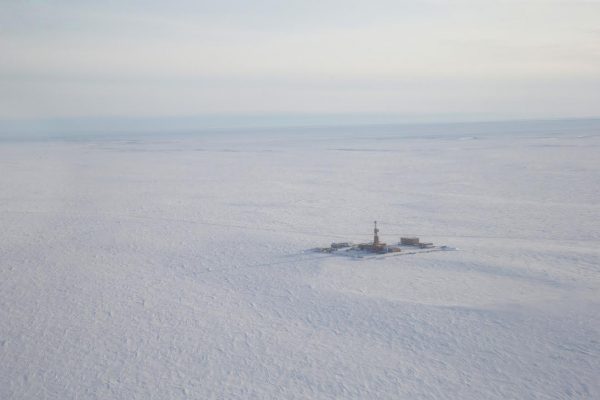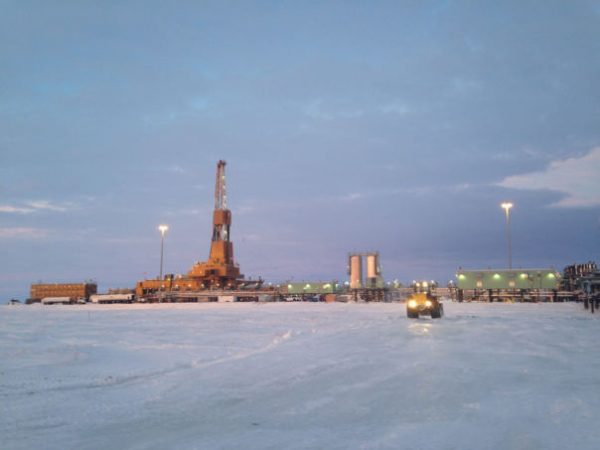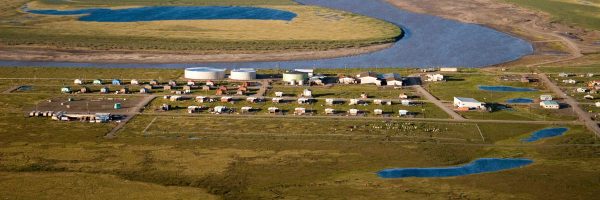
A federal appeals panel has halted work at one of Alaska’s biggest proposed North Slope oil fields, putting dozens of contractors out of work and costing ConocoPhillips, the project’s developer, millions of dollars.
The two-judge panel, from the Ninth Circuit Court of Appeals, issued its emergency order late Saturday.
It comes a week after a pair of Alaska Native-owned corporations hired by Conoco started building ice roads over frozen tundra to access the site of a proposed gravel mine to support construction of the oil company’s massive Willow project, according to court documents. And given the short length of the North Slope’s winter construction season, the ruling will thwart Conoco’s development plans until next January.
The Willow development is one of the largest proposed projects in years on the North Slope, where total oil production has leveled off around 500,000 barrels a day after decades of decline.
At its peak, Willow, located in the National Petroleum Reserve in Alaska, could add another 150,000 barrels a day to that figure — if Conoco ultimately decides to invest the $2 billion or more needed to build it. But the court’s ruling Saturday is an indication of the new legal and political obstacles standing in the project’s way.
Just two years ago, industry boosters — including Conoco’s top Alaska executive — were hailing Willow as one of multiple promising projects in what they called a “North Slope renaissance,” buoyed by the Trump administration’s “energy dominance” agenda.
Related: Q&A: ConocoPhillips Alaska president discusses his prediction for a ‘North Slope Renaissance’
Today, Alaska’s oil industry is contending with a new presidential administration that’s pledging decisive action on carbon emissions and has already issued a temporary moratorium on all activity around leasing in the Arctic National Wildlife Refuge. And a pressure campaign by opponents of oil development in the refuge has convinced an array of banks and other financial institutions to rule out financing of drilling projects anywhere in the Arctic.
Now, Conoco’s Willow project faces new headwinds. In issuing its Saturday injunction temporarily halting work on the gravel mine and a related three-mile road extension, the Ninth Circuit judges noted that the project’s opponents, who requested the order, also have a good chance of winning their underlying lawsuit challenging the Trump administration’s environmental review of the full Willow project.
Project opponents hope that the judges’ decision Saturday will prompt the Biden administration to re-evaluate the costs and benefits of development in the petroleum reserve, according to Bridget Psarianos, an attorney with the environmental law firm Trustees for Alaska.
“It does come at a moment where it seems like we might have an administration that might question that business as usual approach,” said Psarianos, who’s working on the case. “I’m hoping that this gives us a lot of time to think clearly about the future of this case and the future of this project.”

A Conoco spokeswoman, Natalie Lowman, said the company is reviewing its options and will have more to add in the next few days.
Reserve’s future in question
The legal dispute over Willow marks an escalation in the fight over the future of the Indiana-sized petroleum reserve, which is still mostly undeveloped except its easternmost corner.
Environmental organizations, tourism interests and certain Indigenous groups are opposed to expanded development, citing impacts on the neighboring village of Nuiqsut, risks to fish and wildlife and the global push to reduce fossil fuel consumption.
Related: A new oil boom on Alaska’s North Slope is encircling a village, and residents have raised a red flag
They also note that while the reserve is named for its oil potential, it contains critically important habitat for caribou and birds, and the legislation that governs its management directs the Interior Department to keep environmental and scenic values in mind.
Oil companies, meanwhile, have pushed to advance development further west. And those efforts got a boost from the Trump administration, which approved major projects and also rewrote the overarching land use plan for the entire reserve to open more areas to drilling.
While Iñupiat-led corporations and political leaders have supported continued oil development balanced with mitigation measures, Conoco’s original plans for Willow provoked opposition among Nuiqsut residents and North Slope elected officials. And the company ultimately made major changes to its proposal in response to the initial backlash.
Related: Conoco shelves proposal to build a temporary island after criticism from North Slope
After the Trump administration approved the project in October, opponents sued in federal court. They claimed the decision violated several bedrock environmental laws, from the National Environmental Policy Act to the Clean Water Act.
A month later, the opponents asked U.S. District Court Judge Sharon Gleason to block Conoco’s work at Willow while the lawsuit played out.
Gleason initially rejected the request, saying the opponents had failed to file their lawsuit within a required 60-day window after the Trump administration’s approval of the project. But she then granted the request for two weeks to allow opponents to appeal to the Ninth Circuit.
The Ninth Circuit’s emergency ruling could ultimately be lifted. But the court’s briefing schedule will push a decision into late April — too late to allow construction to resume this year.
Conoco’s project manager, James Brodie, said in a sworn statement that any construction left unfinished by mid-April will have to wait at least until January 2022.
The company already had roughly 60 workers involved in Willow-related ice road construction and support, and it planned to employ double that number at the project’s peak this winter, Brodie said. A court order blocking construction will put many of those people “out of work,” he added.
Conoco also had already started moving culverts from Fairbanks to the North Slope, and will have “wasted” nearly $4 million on contracts if its winter work is canceled, Brodie said.
Brodie downplayed the impacts of this winter’s plans at Willow, saying that the work was a “small portion” of construction in the petroleum reserve and noting that more than 500 people are working at a separate Conoco project nearby called GMT2.
“This GMT2 work will continue and maintain an industrial presence in the area regardless of whether the Willow gravel construction is allowed to proceed this winter,” Brodie said.
Conoco still has not made a final decision to build the Willow project, and this winter’s plans amounted to preliminary work, the company said.
Related: Biden immediately slams the brakes on oil drilling in Arctic refuge
But the project’s opponents argued that Conoco’s planned gravel mining and road extension would still cause “irreparable harm” to the reserve’s fish and wildlife, and to their members’ interests in subsistence hunting and fishing, tourism and research.
In a sworn statement, Nuiqsut resident and environmental advocate Rosemary Ahtuangaruak said she was concerned about the new infrastructure blocking subsistence wildlife, like caribou, from getting to the village’s hunting grounds.
“We won’t have the migration come to us,” Ahtuangaruak said. “There may be (a) smattering of animals that get through the infrastructure, but they will be unhealthy and highly stressed.”

Irreparable harm is one of several legal standards that must be met in order for courts to issue an injunction. In its ruling, the Ninth Circuit judges said they agreed with Willow’s opponents on that point — and also with their argument that they were likely to win their underlying case challenging the whole project, which is another requirement for an injunction.
The two judges cited a point made by Gleason, the lower court judge who initially rejected opponents’ request to block Conoco’s work at Willow based on the two-month time limit.
The project’s opponents argue that Gleason was wrong about the time limit. And if that’s the case, Gleason wrote in one of her orders, the opponents “could well be likely to succeed” in one of their underlying claims challenging the Trump administration’s environmental review of Willow.
Specifically, Gleason cited opponents’ argument that the Trump administration review violated the National Environmental Policy Act by inaccurately estimating Willow’s potential greenhouse gas emissions.
The Ninth Circuit’s ruling, handed down late Saturday, made a big splash on both sides. Psarianos, the attorney for Willow’s opponents, called it a “really big deal.”
But she also noted the broader context of many other legal disputes still playing out on the North Slope.
In addition to the lawsuit challenging Willow, drilling opponents have sued over the Trump administration’s new, less-restrictive management plan for the petroleum reserve, and over the Congressionally-created oil leasing program in the Arctic National Wildlife Refuge.
“We’re looking forward to continuing to work on this case, and just keep fighting it,” Psarianos said. “This is one battle in a long war.”




